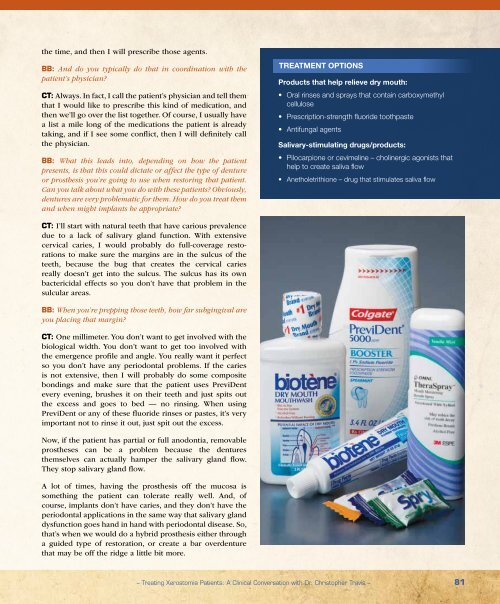PDF Download - Glidewell Dental Labs
PDF Download - Glidewell Dental Labs
PDF Download - Glidewell Dental Labs
Create successful ePaper yourself
Turn your PDF publications into a flip-book with our unique Google optimized e-Paper software.
the time, and then I will prescribe those agents.<br />
BB: And do you typically do that in coordination with the<br />
patient’s physician?<br />
CT: Always. In fact, I call the patient’s physician and tell them<br />
that I would like to prescribe this kind of medication, and<br />
then we’ll go over the list together. Of course, I usually have<br />
a list a mile long of the medications the patient is already<br />
taking, and if I see some conflict, then I will definitely call<br />
the physician.<br />
BB: What this leads into, depending on how the patient<br />
presents, is that this could dictate or affect the type of denture<br />
or prosthesis you’re going to use when restoring that patient.<br />
Can you talk about what you do with these patients? Obviously,<br />
dentures are very problematic for them. How do you treat them<br />
and when might implants be appropriate?<br />
TREATMENT Options<br />
Products that help relieve dry mouth:<br />
• Oral rinses and sprays that contain carboxymethyl<br />
cellulose<br />
• Prescription-strength fluoride toothpaste<br />
• Antifungal agents<br />
Salivary-stimulating drugs/products:<br />
• Pilocarpione or cevimeline – cholinergic agonists that<br />
help to create saliva flow<br />
• Anetholetrithione – drug that stimulates saliva flow<br />
CT: I’ll start with natural teeth that have carious prevalence<br />
due to a lack of salivary gland function. With extensive<br />
cervical caries, I would probably do full-coverage restorations<br />
to make sure the margins are in the sulcus of the<br />
teeth, because the bug that creates the cervical caries<br />
really doesn’t get into the sulcus. The sulcus has its own<br />
bactericidal effects so you don’t have that problem in the<br />
sulcular areas.<br />
BB: When you’re prepping those teeth, how far subgingival are<br />
you placing that margin?<br />
CT: One millimeter. You don’t want to get involved with the<br />
biological width. You don’t want to get too involved with<br />
the emergence profile and angle. You really want it perfect<br />
so you don’t have any periodontal problems. If the caries<br />
is not extensive, then I will probably do some composite<br />
bondings and make sure that the patient uses PreviDent<br />
every evening, brushes it on their teeth and just spits out<br />
the excess and goes to bed — no rinsing. When using<br />
PreviDent or any of these fluoride rinses or pastes, it’s very<br />
important not to rinse it out, just spit out the excess.<br />
Now, if the patient has partial or full anodontia, removable<br />
prostheses can be a problem because the dentures<br />
themselves can actually hamper the salivary gland flow.<br />
They stop salivary gland flow.<br />
A lot of times, having the prosthesis off the mucosa is<br />
something the patient can tolerate really well. And, of<br />
course, implants don’t have caries, and they don’t have the<br />
periodontal applications in the same way that salivary gland<br />
dysfunction goes hand in hand with periodontal disease. So,<br />
that’s when we would do a hybrid prosthesis either through<br />
a guided type of restoration, or create a bar overdenture<br />
that may be off the ridge a little bit more.<br />
– Treating Xerostomia Patients: A Clinical Conversation with Dr. Christopher Travis – 81

















